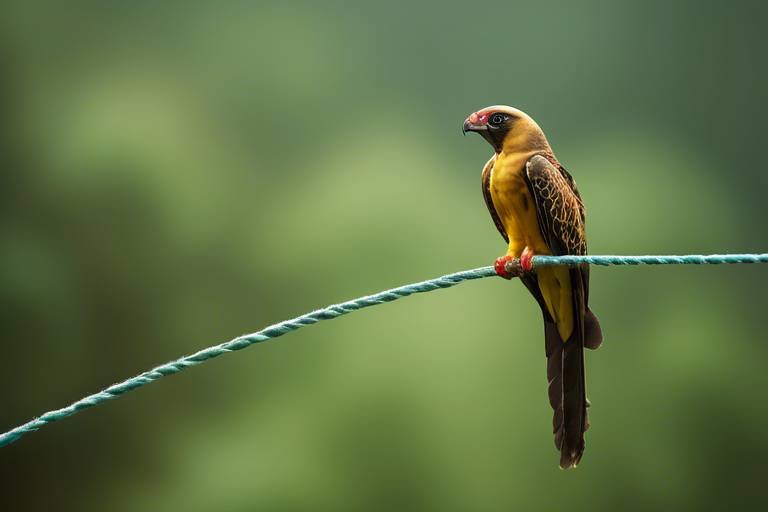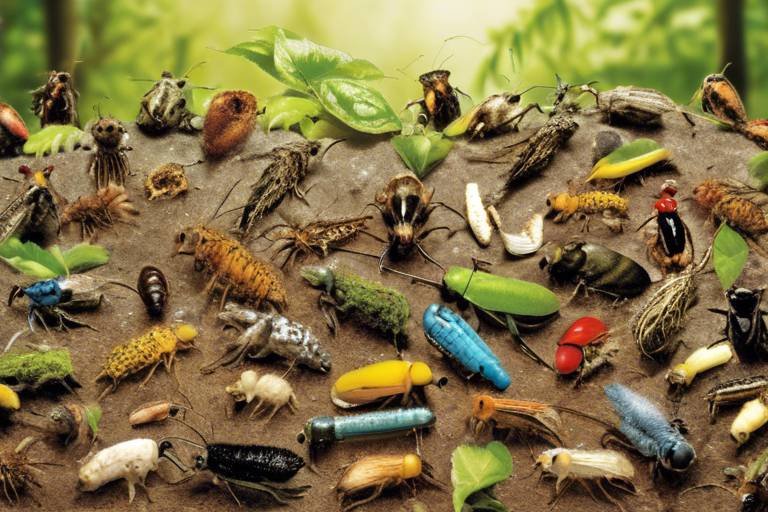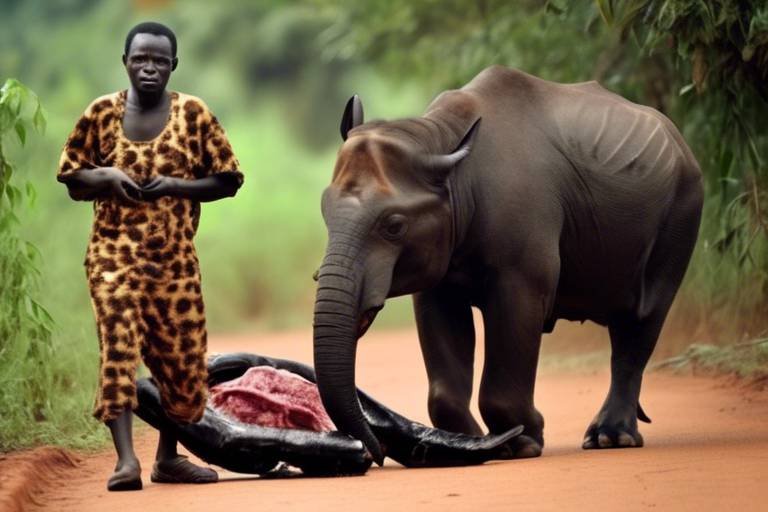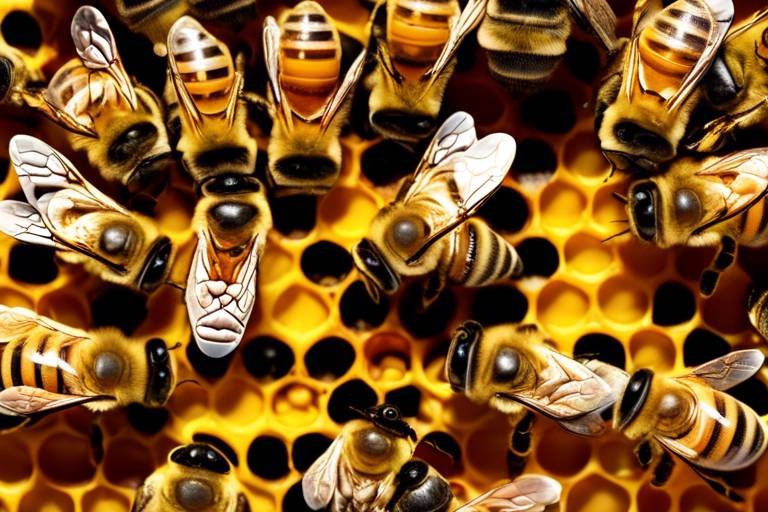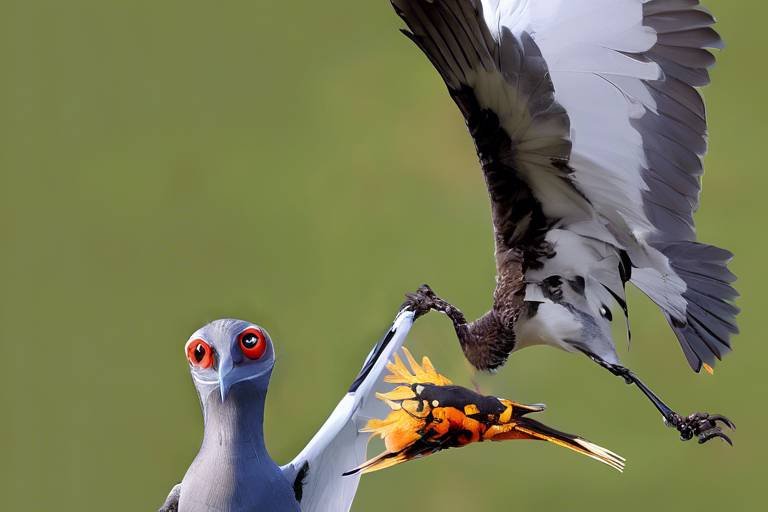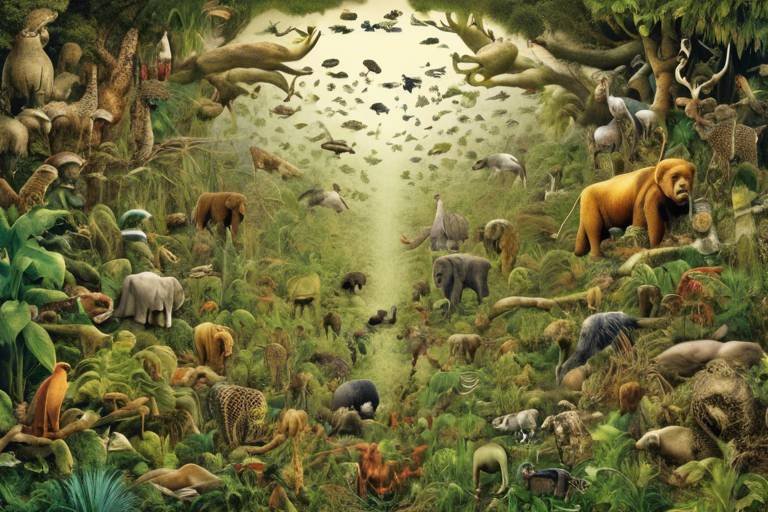The Urgency of Protecting Biodiversity Hotspots
In a world where the clock is ticking faster than ever, the urgency of protecting biodiversity hotspots cannot be overstated. These unique regions, teeming with life and endemic species, are like the lungs of our planet, breathing vitality into our ecosystems. However, they are under siege from a myriad of threats that could lead to irreversible damage. Imagine walking through a vibrant rainforest, the sounds of chirping birds and rustling leaves surrounding you, only to realize that this paradise is fading away. This is the stark reality we face today, and it calls for immediate action.
Biodiversity hotspots are not just random patches of land; they are crucial for maintaining ecological balance. They provide essential services such as clean air, water purification, and climate regulation. But what happens when these ecosystems start to crumble? The effects ripple through the environment, affecting not just the flora and fauna but also human communities that depend on these natural resources. The urgency to act is not just an environmental issue; it is a matter of survival for countless species, including our own.
As we dive deeper into this article, we will explore the definition of biodiversity hotspots, the current threats they face, and the conservation strategies that can help preserve these vital ecosystems. It’s time to shine a spotlight on these magnificent areas and recognize their importance in the grand tapestry of life on Earth. Are we ready to take on this challenge and ensure that future generations inherit a planet rich in biodiversity? The answer lies in our collective actions today.

Understanding Biodiversity Hotspots
Biodiversity hotspots are like nature's treasure chests—regions that are not only teeming with life but also home to a staggering number of unique species found nowhere else on Earth. To qualify as a biodiversity hotspot, a region must meet two key criteria: it must contain at least 1,500 species of vascular plants as endemics and it must have lost at least 70% of its original habitat. This definition underscores the critical significance of these areas, highlighting their role as reservoirs of biological wealth.
Why should we care about biodiversity hotspots? The answer is simple: they are essential for maintaining the health of our planet. These regions provide vital ecosystem services such as clean air, water filtration, and carbon sequestration, which are crucial for combating climate change. Moreover, they are often home to indigenous communities whose cultures and livelihoods are intricately linked to the natural world around them. The loss of biodiversity hotspots would not only mean the extinction of countless species but also the erosion of cultural heritage and traditional knowledge.
To put it into perspective, think of biodiversity hotspots as the Earth's equivalent of a supermarket filled with unique ingredients. If we allow these hotspots to be depleted, we risk losing not just the ingredients themselves but also the recipes—our ecological knowledge and the ability to sustain life on this planet. According to the Global Biodiversity Outlook, we are currently witnessing a rapid decline in biodiversity, and hotspots are among the most affected areas.
Here’s a brief overview of some of the world's most recognized biodiversity hotspots:
| Hotspot Name | Location | Notable Endemic Species |
|---|---|---|
| Amazon Rainforest | South America | Amazonian manatee, Pink river dolphin |
| Madagascar and the Indian Ocean Islands | Madagascar | Lemurs, Baobab trees |
| Western Ghats and Sri Lanka | India and Sri Lanka | Nilgiri Tahr, Sri Lankan elephant |
In summary, understanding biodiversity hotspots is not just about recognizing their beauty and uniqueness; it’s about acknowledging their vital role in sustaining life on Earth. Protecting these areas is an urgent priority, as they are under constant threat from human activities. By raising awareness and taking action, we can ensure that these invaluable ecosystems continue to thrive for generations to come.

Current Threats to Biodiversity Hotspots
Biodiversity hotspots are not just beautiful landscapes teeming with life; they are essential to the health of our planet. However, they are facing an array of threats that are rapidly diminishing their ecological integrity. The challenges these regions face are multifaceted and complex, driven by human activities and environmental changes. Understanding these threats is crucial if we want to take effective action to preserve these vital ecosystems for future generations. So, what are the main threats to biodiversity hotspots?
One of the most pressing issues is deforestation. Forests are being cut down at an alarming rate, primarily for agriculture, logging, and urban development. This not only leads to habitat loss but also disrupts the intricate web of life that exists within these ecosystems. For instance, in tropical regions, vast swathes of rainforest are cleared every minute, resulting in the loss of countless species and the degradation of the environment. The consequences of deforestation ripple through the ecosystem, affecting everything from soil quality to water cycles.
In addition to deforestation, biodiversity hotspots are also grappling with the harsh realities of climate change. As global temperatures rise, habitats are altered, and species that once thrived in specific conditions are forced to adapt or face extinction. For example, coral reefs, which are among the most diverse ecosystems on the planet, are suffering from bleaching due to rising sea temperatures. This not only threatens marine life but also the livelihoods of millions of people who depend on these ecosystems for food and income.
Another significant threat is pollution. From plastic waste in oceans to pesticides in agricultural lands, pollution is a silent killer of biodiversity. It contaminates the habitats of countless species, leading to declines in population and, in some cases, extinction. The effects of pollution are often insidious, slowly degrading the health of ecosystems over time. For instance, waterways that once supported a rich variety of fish and plant life are now choked with toxins, drastically altering the natural balance.
Moreover, the introduction of invasive species poses a severe risk to native flora and fauna. These non-native species can outcompete local species for resources, disrupt food chains, and alter habitats. The impact of invasive species can be devastating, leading to the decline or extinction of indigenous species that have no natural defenses against these newcomers. A classic example is the introduction of the brown tree snake in Guam, which has led to the extinction of several native bird species.
To illustrate the severity of these threats, consider the following table that summarizes the key challenges facing biodiversity hotspots:
| Threat | Description | Impact on Biodiversity |
|---|---|---|
| Deforestation | Clearing of forests for agriculture and development | Habitat loss, species extinction |
| Climate Change | Global temperature rise affecting ecosystems | Altered habitats, species migration |
| Pollution | Contamination of air, water, and soil | Declining health of ecosystems, species decline |
| Invasive Species | Non-native species disrupting local ecosystems | Competition with native species, habitat alteration |
In summary, the threats facing biodiversity hotspots are interconnected and require urgent action. Addressing these challenges is not just about saving unique species; it’s about preserving the intricate ecosystems that sustain life on Earth. Without immediate and concerted efforts, we risk losing not only the beauty of these regions but also the invaluable services they provide to humanity.

Deforestation and Habitat Loss
Deforestation is not just a buzzword; it’s a **cry for help** from our planet. Every year, millions of acres of forests are cut down, leading to a rapid decline in biodiversity. But what exactly does this mean for our ecosystems? When we talk about habitat loss, we’re referring to the destruction of the natural environments that countless species call home. Imagine a bustling city where everyone suddenly has to leave their houses—this is what deforestation does to wildlife. It forces them out of their habitats, disrupting their lives and threatening their survival.
The drivers of deforestation are numerous and often interlinked. **Agricultural expansion** is one of the biggest culprits, as farmers clear forests to make way for crops and livestock. Additionally, logging, both legal and illegal, contributes significantly to habitat loss. Urbanization is another factor, as cities expand and encroach upon forested areas. The consequences of these activities are far-reaching. When forests are cleared, not only are we losing trees, but we are also destroying the intricate web of life that depends on those trees.
The impact on wildlife is profound. Many species face extinction as their homes are destroyed. For instance, the orangutan, which resides in the rainforests of Borneo and Sumatra, has seen its population decline dramatically due to habitat destruction. In fact, according to the World Wildlife Fund (WWF), the orangutan population has decreased by over 50% in the last 60 years. The loss of such iconic species is not just a tragedy; it signals a larger problem within the ecosystem. When one species disappears, it can set off a chain reaction that affects many others. The delicate balance of nature is disrupted, leading to further declines in biodiversity.
Moreover, the socioeconomic consequences of deforestation cannot be overlooked. Local communities often depend on forests for their livelihoods—think of the fruits, nuts, and timber that many people rely on for food and income. When these forests are destroyed, these communities face dire consequences. They may lose their source of income, leading to increased poverty and social unrest. Additionally, the loss of forests contributes to climate change, as trees play a crucial role in absorbing carbon dioxide. Without them, we’re not just losing biodiversity; we’re also exacerbating global warming.
In summary, deforestation and habitat loss are urgent issues that require immediate attention. The **interconnectedness** of species and their habitats means that when we lose one, we risk losing many others. The time to act is now, and understanding these dynamics is the first step toward effective conservation efforts. We must advocate for sustainable practices and policies that protect our forests and the incredible biodiversity they harbor.
- What are biodiversity hotspots? Biodiversity hotspots are regions that are rich in endemic species but are also experiencing significant habitat loss.
- How does deforestation affect climate change? Deforestation contributes to climate change by releasing stored carbon dioxide into the atmosphere, which increases greenhouse gas levels.
- What can individuals do to help combat deforestation? Individuals can support sustainable products, reduce paper usage, and participate in reforestation efforts.
- Why is community engagement important in conservation? Local communities often have a vested interest in protecting their environment and can provide valuable knowledge and resources for conservation efforts.

Impact on Wildlife
The consequences of habitat destruction due to deforestation are profound and far-reaching, affecting not just the flora but also the fauna that depend on these ecosystems. Imagine a vibrant forest, teeming with life—birds flitting between branches, monkeys swinging from tree to tree, and insects buzzing about. Now, picture that same forest stripped bare, leaving behind a desolate landscape. This stark transformation is the reality for many biodiversity hotspots around the globe. The loss of habitat leads to a cascade of negative effects on wildlife, pushing numerous species to the brink of extinction.
One of the most alarming impacts of deforestation is the **fragmentation** of habitats. When large areas of forest are cut down, the remaining patches become isolated islands of biodiversity. This isolation can make it nearly impossible for species to find mates, leading to reduced genetic diversity and, ultimately, population decline. For example, the **Sumatran orangutan**, which relies heavily on the dense canopy of tropical forests, has seen its population plummet due to habitat loss. With fewer trees to live in and limited opportunities for mating, the future of this incredible species hangs in the balance.
Moreover, the disappearance of one species can have a **domino effect** on the entire ecosystem. Predators, prey, and plants are all interconnected in a delicate web of life. When a key species disappears, such as the **top predators** that regulate populations of herbivores, it can lead to overpopulation of certain species, which in turn can decimate plant life. This imbalance can result in a loss of biodiversity that is difficult to reverse, as many species rely on a **diverse ecosystem** for survival.
Additionally, the impact of habitat loss is not limited to just the animals that live in those areas. Local communities that rely on wildlife for food, medicine, and cultural practices are also affected. For instance, indigenous tribes in the Amazon rainforest depend on the rich biodiversity for their livelihoods. As deforestation continues, they face a future where their traditional ways of life are threatened, leading to a loss of cultural heritage alongside the loss of wildlife.
To illustrate the severity of this situation, consider the following table, which highlights some critically endangered species and the primary threats they face due to habitat loss:
| Species | Habitat | Primary Threats |
|---|---|---|
| Sumatran Orangutan | Tropical Rainforest | Deforestation, Palm Oil Plantations |
| Amur Leopard | Temperate Forest | Habitat Fragmentation, Poaching |
| Javan Rhinoceros | Tropical Forest | Habitat Loss, Poaching |
| Vaquita | Marine Ecosystem | Bycatch, Pollution |
In summary, the impact of deforestation on wildlife is not just an environmental issue; it is a **crisis** that threatens the very fabric of our planet's biodiversity. The loss of species, the disruption of ecosystems, and the socioeconomic consequences for local communities create a complex web of challenges. It is essential that we recognize the urgency of this situation and take proactive steps to protect these invaluable ecosystems before it's too late.
Q: What are biodiversity hotspots?
A: Biodiversity hotspots are regions that are both rich in endemic species and experiencing significant habitat loss. They are crucial for conservation efforts due to their unique flora and fauna.
Q: Why is deforestation a major threat to wildlife?
A: Deforestation leads to habitat loss and fragmentation, making it difficult for species to survive, find mates, and maintain healthy populations. This can result in extinction and a decline in biodiversity.
Q: How does climate change affect biodiversity hotspots?
A: Climate change alters habitats, disrupts food chains, and can lead to the extinction of species that cannot adapt quickly enough to changing conditions.
Q: What can be done to protect biodiversity hotspots?
A: Effective conservation strategies include establishing protected areas, promoting sustainable practices, and engaging local communities in conservation efforts.

Socioeconomic Consequences
The loss of biodiversity is not just an environmental issue; it's a profound socioeconomic crisis that affects millions of people worldwide. When ecosystems are disrupted, the consequences ripple through local communities, often hitting the most vulnerable populations the hardest. Imagine relying on a thriving forest for your livelihood, only to watch it disappear due to deforestation. This is the harsh reality for many who depend on natural resources for their daily survival.
One of the most immediate impacts of biodiversity loss is the decline in resources that local communities depend on. For instance, many indigenous peoples rely on forests for food, medicine, and shelter. As these ecosystems degrade, so do their means of survival. The loss of fish stocks due to overfishing, the extinction of plant species used for traditional medicine, and the disappearance of pollinators crucial for agriculture all contribute to a precarious existence for these communities.
Furthermore, the economic implications are staggering. Biodiversity hotspots often attract tourism, which can be a significant source of income for local economies. When these areas suffer from habitat destruction, the tourism appeal diminishes. This leads to a decline in revenue, which can create a cycle of poverty and unemployment. For example, a vibrant coral reef can draw divers and snorkelers from around the globe, but if climate change and pollution lead to coral bleaching, the local economy suffers as tourists seek alternative destinations.
Moreover, the loss of biodiversity can exacerbate food insecurity. As ecosystems collapse, agricultural systems become less resilient to pests and diseases, leading to lower crop yields. This situation forces communities to rely on a limited number of crops, making them more susceptible to famine and malnutrition. According to the Food and Agriculture Organization (FAO), biodiversity is essential for food security, and its loss can lead to a decrease in dietary diversity, further impacting health outcomes.
The interconnectedness of biodiversity and human well-being is evident in the following table, which highlights some key socioeconomic consequences of biodiversity loss:
| Impact | Description |
|---|---|
| Resource Decline | Reduction in food, medicine, and materials available to local communities. |
| Economic Loss | Decrease in tourism revenue and job opportunities linked to natural ecosystems. |
| Food Insecurity | Increased vulnerability to famine due to reduced agricultural diversity and resilience. |
| Health Risks | Higher incidence of malnutrition and related health issues due to reliance on fewer food sources. |
In conclusion, the socioeconomic consequences of biodiversity loss are profound and multifaceted. As we witness the degradation of these vital ecosystems, it is crucial to recognize that protecting biodiversity is not just about saving species; it is about safeguarding the livelihoods and well-being of countless individuals. Addressing these challenges requires a concerted effort from governments, NGOs, and local communities to implement sustainable practices and ensure that both nature and people can thrive together.
- What are biodiversity hotspots? Biodiversity hotspots are regions that are rich in endemic species but are also experiencing significant habitat loss.
- Why are biodiversity hotspots important? They are crucial for maintaining ecological balance, supporting livelihoods, and preserving unique species.
- What are the main threats to biodiversity hotspots? Major threats include deforestation, climate change, pollution, and overexploitation of resources.
- How can we help protect biodiversity hotspots? Supporting conservation efforts, promoting sustainable practices, and engaging with local communities are vital steps.

Climate Change Effects
Climate change is not just a distant threat; it is a reality that is reshaping our planet in profound ways. Biodiversity hotspots, which are already under siege from various human activities, are particularly vulnerable to the impacts of climate change. As temperatures rise and weather patterns become increasingly erratic, these delicate ecosystems face a myriad of challenges that can alter their very fabric. Imagine a tightly woven tapestry; when you start pulling on one thread, the entire piece begins to unravel. That’s exactly what happens to biodiversity hotspots when climate change takes hold.
One of the most alarming effects of climate change is the shifting of habitats. Species that have thrived in certain regions for millennia are finding their homes becoming inhospitable. For instance, as temperatures increase, many plants and animals are forced to migrate to cooler areas, typically higher altitudes or latitudes. This migration can lead to overcrowding in new areas, putting additional stress on resources and leading to competition among species. In some cases, species may not be able to move fast enough or at all, resulting in local extinctions.
Additionally, the changes in climate can disrupt the intricate relationships between species. For example, if a plant species blooms earlier due to warmer temperatures, the insects that depend on it for food may not adjust their life cycles accordingly. This mismatch can have devastating effects on entire ecosystems. The ripple effects can be far-reaching, affecting not just individual species but entire food webs.
Moreover, climate change exacerbates existing threats such as deforestation and pollution. As forests become more vulnerable to pests and diseases due to changing climates, the rate of deforestation may increase, further diminishing the habitats available for countless species. The loss of these habitats, in turn, contributes to greater carbon emissions, creating a vicious cycle that is hard to break.
To illustrate the impact of climate change on biodiversity hotspots, consider the following table that outlines some key effects:
| Effect | Description | Example |
|---|---|---|
| Habitat Loss | Species forced to migrate to new areas due to unsuitable conditions. | Polar bears losing ice habitat in the Arctic. |
| Altered Species Interactions | Changes in timing of life cycles disrupting ecological relationships. | Flowers blooming before pollinators emerge. |
| Increased Vulnerability | Species already at risk become more susceptible to extinction. | Amphibians facing habitat changes and disease outbreaks. |
As we look ahead, it’s clear that combating climate change is not just an environmental issue; it’s a matter of preserving the incredible diversity of life on our planet. The survival of many species hinges on our ability to mitigate these changes and adapt our conservation strategies accordingly. It’s a race against time, and every action counts. So, what can we do? Engaging in sustainable practices, reducing our carbon footprint, and supporting conservation efforts can make a significant difference. Together, we can help ensure that biodiversity hotspots remain vibrant and resilient in the face of climate change.
- What are biodiversity hotspots?
Biodiversity hotspots are regions that are rich in endemic species but are experiencing significant habitat loss. - How does climate change affect biodiversity?
Climate change alters habitats, disrupts species interactions, and increases the vulnerability of species, leading to potential extinctions. - What can be done to protect biodiversity hotspots?
Effective conservation strategies, including the establishment of protected areas and community engagement, are essential to preserving these vital ecosystems.

Conservation Strategies for Biodiversity Hotspots
To effectively safeguard biodiversity hotspots, a multi-faceted approach is crucial. These regions, teeming with unique species and ecosystems, require tailored conservation strategies that address their specific needs and challenges. One of the primary methods involves establishing protected areas and reserves. These designated zones serve as safe havens for flora and fauna, shielding them from the rampant destruction caused by human activities. However, simply creating these areas isn’t enough; ongoing management and enforcement are essential to ensure that they fulfill their protective roles.
Protected areas can vary significantly in size and purpose, ranging from national parks to wildlife reserves. The effectiveness of these areas largely depends on their design and management. For instance, a well-planned reserve can maintain ecological integrity while allowing for sustainable use of resources by local communities. Yet, the implementation of such strategies often encounters hurdles, including insufficient funding, lack of political will, and encroachment from agricultural and urban development. To overcome these challenges, it is vital to integrate scientific research with local knowledge, creating a comprehensive conservation plan that resonates with both ecological and human needs.
Another cornerstone of conservation strategies is the engagement of local communities. The involvement of indigenous and local populations in conservation efforts can lead to more sustainable and effective outcomes. When communities are actively engaged, they tend to have a vested interest in preserving their natural surroundings. This can be achieved through education and awareness programs, which highlight the importance of biodiversity and the role it plays in their daily lives. Moreover, empowering locals to manage resources can foster a sense of ownership and responsibility towards their environment.
In addition to protected areas and community engagement, adopting sustainable practices is fundamental to conservation efforts. This includes promoting eco-friendly agricultural techniques, sustainable forestry, and responsible tourism. For example, agroforestry systems that integrate trees and shrubs into agricultural landscapes can enhance biodiversity while providing economic benefits to farmers. By shifting towards more sustainable practices, we can reduce the adverse impacts on biodiversity hotspots and pave the way for a healthier planet.
To summarize, the conservation of biodiversity hotspots is a complex yet imperative task that requires a collaborative approach. By establishing protected areas, empowering local communities, and promoting sustainable practices, we can work towards preserving these vital ecosystems for future generations. The path forward may be challenging, but with collective effort and innovative strategies, we can make significant strides in safeguarding our planet's rich biodiversity.
- What are biodiversity hotspots? Biodiversity hotspots are regions that are rich in endemic species but are also experiencing significant habitat loss.
- Why are protected areas important? Protected areas serve as safe havens for wildlife, helping to conserve ecosystems and prevent habitat destruction.
- How can local communities contribute to conservation? Engaging local communities in conservation efforts fosters a sense of ownership and responsibility, leading to more sustainable outcomes.
- What role does sustainable agriculture play in conservation? Sustainable agriculture practices help reduce the negative impacts on biodiversity, allowing ecosystems to thrive while providing resources for local populations.

Protected Areas and Reserves
When it comes to safeguarding our planet's rich tapestry of life, are like the lifeboats in a turbulent sea. These designated spaces are crucial for conserving biodiversity, acting as sanctuaries for countless species that might otherwise face extinction. But what exactly are these areas? In simple terms, they are regions set aside by governments or organizations where human activity is limited or regulated to ensure the protection of the natural environment. Think of them as nature’s safe havens, where flora and fauna can thrive without the incessant pressures of urban development, agriculture, and pollution.
One of the most significant aspects of protected areas is their ability to maintain ecological balance. They play a vital role in preserving not just individual species but entire ecosystems. For instance, a well-managed reserve can support complex interactions among plants, animals, and microorganisms, which are essential for nutrient cycling, pollination, and even climate regulation. However, the effectiveness of these areas can vary widely based on factors such as location, size, and management practices. Some reserves flourish, while others struggle under the weight of inadequate funding, poor governance, or external threats.
It's important to understand that simply establishing a protected area is not enough. Effective management is key. This includes regular monitoring of wildlife populations, habitat restoration efforts, and community involvement. In fact, local communities often hold invaluable knowledge about the ecosystems they inhabit, making their participation in conservation efforts crucial. For example, in many regions, indigenous groups have been the best stewards of their lands, using traditional practices that promote biodiversity and sustainability.
Here’s a quick look at some of the types of protected areas:
- Nature Reserves: Areas specifically designated for the protection of wildlife and natural habitats.
- National Parks: Protected areas that are often open to the public for recreation and education, while still focusing on conservation.
- Wildlife Sanctuaries: Areas that provide refuge for endangered species, often with stricter regulations on human activity.
Despite their importance, protected areas face numerous challenges. Encroachment from agriculture, illegal logging, and climate change can diminish their effectiveness. Moreover, many reserves are too small to support viable populations of large animals, leading to genetic bottlenecks and increased vulnerability to extinction. This is why it’s essential to not only create more protected areas but also to connect existing ones through wildlife corridors. These corridors allow species to migrate and adapt to changing environmental conditions, which is increasingly important in our rapidly changing world.
In conclusion, while protected areas and reserves are indispensable tools in our fight to conserve biodiversity, they are not a silver bullet. They require ongoing commitment, resources, and innovative management strategies to ensure they fulfill their purpose. As we move forward, it’s crucial that we recognize the interconnectedness of these ecosystems and the human communities that depend on them. Only then can we hope to create a sustainable future for both nature and humanity.
Q1: What is a biodiversity hotspot?
A biodiversity hotspot is a biogeographic region that is both a significant reservoir of biodiversity and is threatened by human activities. To qualify, a region must contain at least 1,500 species of vascular plants as endemics and it must have lost at least 70% of its original habitat.
Q2: Why are protected areas important?
Protected areas are critical for conserving biodiversity, protecting ecosystems, and providing a refuge for endangered species. They help maintain ecological balance and can also serve as sites for scientific research and education.
Q3: How can local communities contribute to conservation efforts?
Local communities can play a vital role in conservation by sharing their traditional knowledge, participating in sustainable practices, and being actively involved in the management of protected areas. Their engagement often leads to more effective and sustainable conservation outcomes.

Community Engagement in Conservation
When it comes to conserving biodiversity hotspots, one of the most powerful tools we have at our disposal is the active involvement of local communities. These communities not only have a deep-rooted connection to their natural surroundings but also possess invaluable knowledge about the ecosystems they inhabit. Engaging them in conservation efforts can lead to more effective and sustainable outcomes. Why is this so important? Well, think of local communities as the stewards of their land. They understand the rhythms of nature and have lived in harmony with it for generations. By tapping into this rich reservoir of knowledge, conservationists can create strategies that are not only scientifically sound but also culturally relevant.
Moreover, when communities are involved in conservation, they are more likely to value and protect their natural resources. This engagement can take various forms, from participatory monitoring of wildlife populations to sustainable land-use practices. For instance, in many regions, local farmers have been trained to adopt agroforestry techniques, which not only enhance biodiversity but also improve their livelihoods. By integrating conservation into their daily lives, these communities become champions for the environment, advocating for policies that protect their ecosystems.
However, it's not just about providing education and resources; it's also about building trust. Conservation efforts must be collaborative, not top-down impositions. When communities feel like they have a stake in the conservation process, they are more likely to engage positively. This involves recognizing their rights, listening to their concerns, and ensuring that they benefit from conservation initiatives. For example, in some cases, community-based tourism has been developed, allowing locals to earn income while showcasing their natural heritage. This not only helps in preserving biodiversity but also empowers the community economically.
To illustrate the impact of community engagement, consider the following table that highlights successful case studies:
| Location | Conservation Initiative | Community Involvement | Outcome |
|---|---|---|---|
| Amazon Rainforest | Community-based forest management | Local tribes participate in sustainable logging | Increased forest cover and improved livelihoods |
| Great Barrier Reef, Australia | Indigenous marine management | Traditional ecological knowledge applied to reef conservation | Healthier reef ecosystems and cultural preservation |
| Andes Mountains, Peru | Agroecological practices | Farmers trained in sustainable agriculture | Enhanced biodiversity and food security |
In conclusion, community engagement is not just an add-on but a fundamental aspect of conservation strategies for biodiversity hotspots. By fostering partnerships with local populations, we can create a more resilient and sustainable future for these vital ecosystems. When communities feel empowered and recognized, they become the true defenders of their natural heritage. So, let’s continue to champion their involvement, ensuring that conservation efforts are as diverse and rich as the ecosystems we aim to protect.
- Why is community engagement important in conservation? Community engagement is crucial because local communities have intimate knowledge of their ecosystems and can contribute significantly to sustainable conservation practices.
- How can communities benefit from conservation efforts? Communities can benefit through economic opportunities such as eco-tourism, sustainable agriculture, and access to resources that promote their livelihoods.
- What are some examples of successful community engagement in conservation? Successful examples include community-based forest management in the Amazon and indigenous marine management in Australia.
- How can I get involved in community conservation efforts? You can get involved by supporting local conservation organizations, participating in volunteer programs, or advocating for policies that promote community engagement in conservation.
Frequently Asked Questions
- What are biodiversity hotspots?
Biodiversity hotspots are regions that are both rich in unique species and significantly threatened by habitat loss. These areas are crucial for conservation efforts as they hold a large number of endemic species that can be found nowhere else on Earth.
- Why are biodiversity hotspots important?
These hotspots are vital because they contribute to the overall health of our planet. They provide essential ecosystem services, such as clean air and water, and support livelihoods for millions of people. Protecting them is key to maintaining biodiversity and ensuring the survival of numerous species.
- What threats do biodiversity hotspots face?
Biodiversity hotspots are under severe threat from various factors, including deforestation, climate change, pollution, and invasive species. Each of these challenges can lead to habitat destruction and the decline of species populations, making conservation efforts even more critical.
- How does deforestation affect wildlife?
Deforestation leads to habitat loss, which is one of the primary reasons for the decline in wildlife populations. As trees are cut down, animals lose their homes, food sources, and breeding grounds. This can result in species becoming endangered or even extinct.
- What are the socioeconomic impacts of biodiversity loss?
The loss of biodiversity can have dire consequences for local communities that depend on these ecosystems for their livelihoods. It can lead to decreased availability of resources such as food, medicine, and clean water, ultimately affecting the well-being of these populations.
- How does climate change impact biodiversity hotspots?
Climate change alters habitats and disrupts the delicate balance of ecosystems within biodiversity hotspots. Changes in temperature and precipitation can affect species distribution, breeding patterns, and food availability, putting additional stress on already vulnerable species.
- What conservation strategies are effective for protecting biodiversity hotspots?
Effective strategies include establishing protected areas, promoting sustainable land-use practices, and engaging local communities in conservation efforts. By involving indigenous populations, we can create more sustainable outcomes that benefit both biodiversity and local livelihoods.
- How can communities get involved in conservation efforts?
Communities can play a crucial role by participating in local conservation initiatives, supporting sustainable practices, and advocating for policies that protect their natural resources. Education and awareness are also key components in fostering a culture of conservation.


